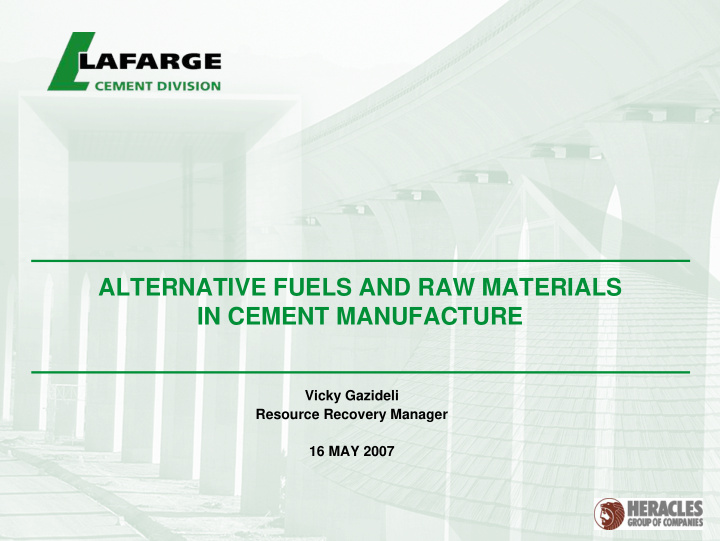



ALTERNATIVE FUELS AND RAW MATERIALS IN CEMENT MANUFACTURE Vicky Gazideli Resource Recovery Manager 16 MAY 2007
GREECE ENERGY � Fuel and electricity represent about 35% of total cement production cost. � Energy savings have reached a critical point (30% reduction since 1970). � Prices of traditional fuels (coal, pet-coke, heavy fuel oil) continuously increase. � Alternative fuels are an interesting solution both financially and environmentally. 2
GREECE INDUSTRIAL ECOLOGY Recycling in cement kilns = Resource saving (A’) + Waste and releases minimization (B’) B A B’ A’ B 3
GREECE BENEFITS ECONOMY The use of alternative fuels counterbalances the high increase of � fossil fuel price, reduces production cost and improves company competitiveness. ENVIRONMENT � Use of AF and ARM in cement production saves non renewable natural resources and recovers both energy and materials because: � Their organic part replaces fossil fuel � Their inorganic part replaces natural raw materials � Pollution due to their uncontrolled disposal in the environment is avoided. � CO 2 emissions are reduced. COMMUNITY � An alternative solution is offered to community for safe disposal of waste 4
GREECE LAFARGE RESOURCE RECOVERY POLICY It specifies strict observance of the following operating conditions : � Respect to relevant & applicable regulations and Lafarge standards � Assure that there are no negative effects on the quality of the end product � Ensure a perfect knowledge and mastering of waste material arriving at the plant � Ensure total transparency vis-a-vis the community � Given the sensitive nature of this issue, it is absolutely essential that the use of waste as a alternative fuel and/or raw material is handled with strict professionalism. 5
GREECE SAFE PROCEDURES AND EXPERIENCE � Use of alternative materials in Heracles is made with respect to environment, health and safety standards and in an absolutely controlled manner. � Lafarge has been using AF and ARM since 1980 and has great experience in their use. � up to 85% recovery rates in terms of liquid waste fuels (Paulding, Fredonia USA) � up to 50% recovery rates for solid waste fuel (Retznei Austria) � In any case it is ensured that there will be no impacts on employee health, environment and the quality of cement. 6
GREECE Lafarge uses 5,5 m tn of AF/ARM all over the world 1 721 852 415 344 649 1 307 327 534 269 506 604 Central Europe 564 289 276 Mediterranean 159 491 10,7 117 N. America 5,4 228 140 126 Asia AF 2003 Africa AF 2004 Latin America ARM 2003 ARM 2004 7
GREECE WHAT CAN BE USED IN OUR PROCESS? Primary raw material Limestone, marl, clay, MATERIAL sand RAW- Cement Clinker GRINDING BURNING Secondary raw material Ca - carrier Si - carrier - foundry sand, waste bricks Fe - carrier - pyrites Grinding additives: Al - carrier - waste bricks Primary: gypsum, anhydride Secondary: REA-gypsum, citric gypsum, gypsum Primary fuels S fracture L Coal, pet coke, fuel oil, E natural gas U F Hydraulically active grinding additives Primary: pozzolan Secondary fuels Secondary: blast-furnace slag, fly ash Waste tires, sludges, solid shredded waste, animal meal, biomass, ... 8
GREECE ALTERNATIVE RAW MATERIALS USE IN HERACLES � Started in 1980 and is continuously adapted to current standards and YEAR QUANTITY (t) availability of materials 2001 1.141.000 � ARM used include: 2002 1.208.000 � Fly ash � Blast furnace and other 2003 1.298.000 types of slag 2004 1.507.000 � Iron mill scale � Red mud 2005 1.216.000 � Waste bauxite 2006 1.156.000 � Pyrite ashes � Chemical gypsum 9
GREECE ALTERNATIVE FUELS USE � Following an extensive review of waste market conditions in Greece several waste streams that could be used were identified, such as: � Tyres � Sewage sludge � Solid shredded waste � Biomass � Main obstacles in Greece seem to be: � Non efficient waste collection systems → small quantities of waste available � Illegal dumping � Low awareness of local communities about benefits of co- incineration → slow permitting procedures, local concerns 10
GREECE ALTERNATIVE FUELS USE � Two major projects are currently in progress: � Use of different types of biomass, i.e. agricultural waste, food industry waste, biodiesel waste, etc. � Use of Solid Shredded Waste from the Waste Recycling & Composting Plant of Attica region � Trials made in 2006 to evaluate impact on process and production � Design of necessary installations is completed and their construction is in progress � We plan to replace (on thermal basis) about 12% of conventional fuels at Milaki plant and about 5% at Volos plant 11
Recommend
More recommend